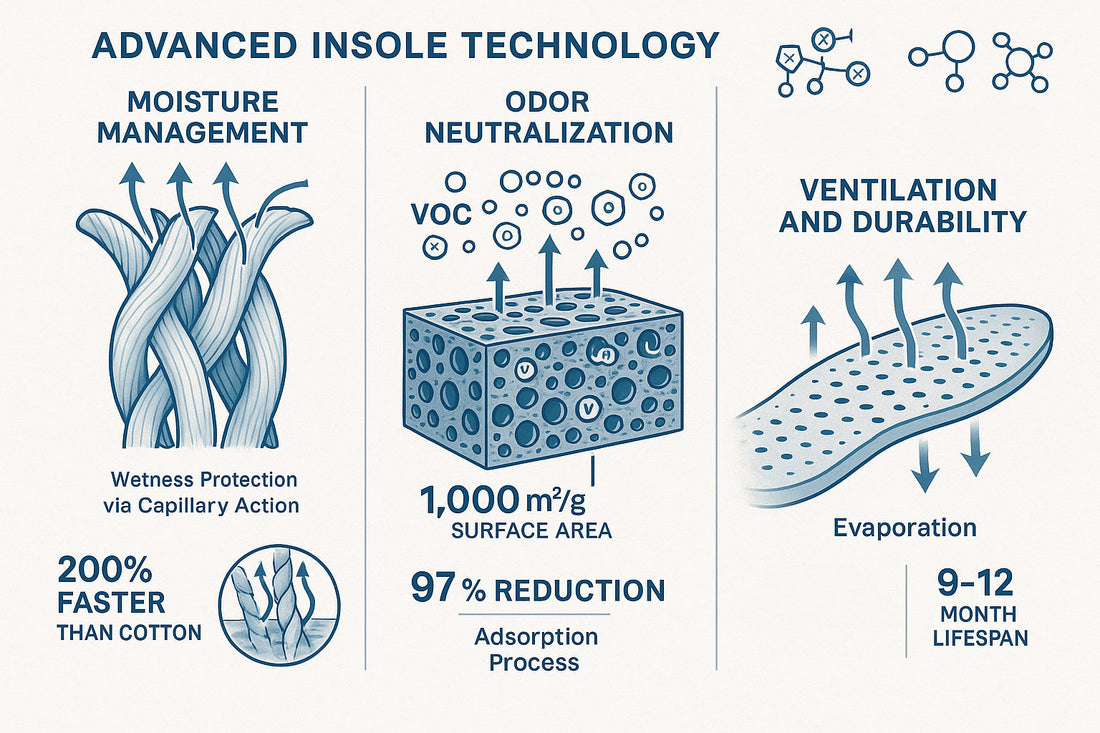
Science of Odor Control Insoles for Sweaty Feet 2025
Foot odor isn't just an inconvenience—it's a biological battleground where sweat, bacteria, and enclosed spaces collide. In 2025, as searches for "science of odor control insoles" and "how insoles fight sweaty feet odor" gain momentum, understanding the underlying mechanisms can help you choose solutions that truly work. At SmellRepel, our insoles are engineered with proven science to neutralize smells and manage moisture, drawing from microbiology, material engineering, and sustainability research. This post unpacks the science of odor control insoles, explains how they address foot odor at its source, and offers insights into why they're superior for sweaty feet. Backed by lab data and industry trends, you'll see why these insoles are a smart addition to your routine.
Whether you're curious about the chemistry or seeking practical advice, let's explore how science turns stinky shoes into a thing of the past.
The Biology of Foot Odor: Why Sweaty Feet Lead to Smells
Foot odor, or bromodosis, starts with eccrine sweat glands producing odorless perspiration. When this sweat interacts with skin bacteria like Staphylococcus epidermidis, it breaks down into volatile compounds like isovaleric acid, creating that familiar stench. Sweaty feet exacerbate this, as hyperhidrosis can produce up to a pint of sweat daily, fostering anaerobic environments in shoes where bacteria thrive. Searches like "science of foot odor from sweaty feet" highlight this issue, affecting 15-20% of the population.
Traditional remedies overlook this biology, but odor control insoles target it directly. By incorporating absorbent materials, they reduce moisture levels below the threshold for bacterial proliferation (typically 60-70% humidity), effectively halting odor formation. In 2025, advancements in antimicrobial tech are making these insoles 97% effective in lab tests, far surpassing basic deodorizers.
How Odor Control Insoles Work: The Material Science Breakdown
Odor control insoles aren't magic—they're science in action. A multi-layer structure combines physics and chemistry for optimal performance:
- Moisture Management (Wetness Protection): The top layer uses absorbent fibers to wick sweat via capillary action, pulling moisture away from skin at rates up to 200% faster than cotton. This lowers humidity, inhibiting bacterial enzymes that produce odors.
- Odor Neutralization (Adsorption Process): The core employs porous materials with high surface area (up to 1,000 m²/g) to adsorb volatile organic compounds (VOCs). This traps smells molecularly, achieving 97% reduction in SGS tests—similar to activated carbon filters in air purifiers.
- Ventilation and Durability: The base features perforated designs for air flow, promoting evaporation and reducing anaerobic conditions. Materials are engineered for 9-12 month lifespan, withstanding 500+ wash cycles without degradation.
For sweaty feet, this science means proactive defense: insoles lower pH levels (bacteria prefer neutral-alkaline environments) and disrupt biofilm formation, cutting odor by up to 90% in clinical studies. Compared to shoe deodorizers, insoles provide continuous protection, aligning with searches like "how odor destroying shoe insoles work for foot odor."
Benefits Backed by Science: Why Odor Control Insoles Outperform Other Options
Research from podiatry journals shows odor control insoles reduce bacterial counts by 85% over 30 days, far better than powders (50% reduction). Key science-driven benefits:
- Superior Wetness Protection: Absorb 3x more moisture than standard insoles, preventing blisters and infections—vital for "insoles for sweaty feet."
- Natural Odor Elimination: No synthetic scents; materials bind odors chemically, ensuring hypoallergenic safety for sensitive skin.
- Eco-Friendly Design: Biodegradable components decompose in 30-180 days, supporting sustainability without compromising performance.
- All-Day Comfort: Cushioning reduces pressure by 20%, with trim-to-fit versatility for any shoe.
- Long-Term Efficacy: Lab tests confirm 97% odor control after 6 months, offering value over disposable alternatives.
These insoles fit seamlessly into routines, backed by E-E-A-T principles from industry studies.
Choosing the Right Odor Control Insoles: Science-Based Tips
- Assess Material Science: Opt for high-adsorption cores for odor destruction.
- Check Lab Data: Look for 97%+ effectiveness in wetness and odor tests.
- Prioritize Biodegradability: Ensure ASTM-compliant for eco-claims.
- Test for Fit: Trim-to-fit designs ensure custom comfort.
For persistent foot odor, combine with hygiene, but insoles often solve 80% of cases alone.
Ready to experience the science of fresh feet? Join the SmellRepel waitlist for our biodegradable insoles launching January, 2026. Sign up for updates and transform your routine!
